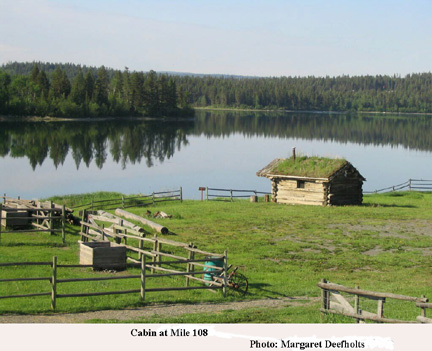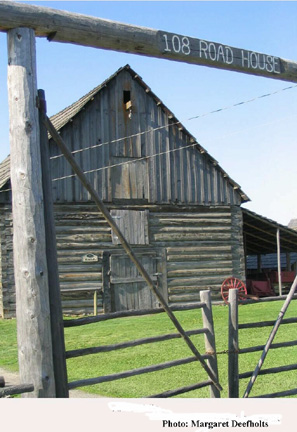 Mere
robbery pales into insignificance the next morning.
Mere
robbery pales into insignificance the next morning.
We are standing at the 108 Historical Site, looking at an idyllic scene—an old barn, a schoolhouse, and a rustic log cabin set against the backdrop of evergreens, their images mirrored on the still waters of a deep blue lake. Hardly the setting for murder most foul. But if the story is to be believed, this is the neighbourhood where Agnes McVee, her husband Jim McVee, and her son in law, Al Riley, set up McVee's Inn during the 1870s.
Agnes, a Scotswoman of voluptuous proportions, was the leader of the trio. She was also Lucretia Borgia, Lizzie Borden, Countess Elizabeth Bartory, and a female version of Marquis de Sade rolled into one.
For starters, Agnes enticed young women (many of them looking for a husband along the gold rush trail) into the hotel. Once inside, the girls were imprisoned in the basement, bound, chained, beaten, and starved into terrified submission. In addition to dealing in the sale of these women, Agnes also provided food, liquor, and lodging for miners and merchants travelling solo on their way to or from Barkerville. Many of them never emerged alive. While Agnes plied her victims with booze, and glimpses of her cleavage, Al Riley armed with a shotgun, drew a bead on their backs from a window, killing them instantly. The bodies were then bundled into a covered wagon, and Jim McVea dumped the remains into one of the many wilderness lakes in the area. Agnes meanwhile cleaned out their possessions, and buried gold and coins in the vicinity of the Inn. As a sideline, Jim collected the men's horses, and when he had a sufficient number to make up a string, he sold the animals at a profit in Fort Kamloops.
Incredibly—perhaps because of the Inn's remote location—the murderous trio remained on the rampage for ten years, until Agnes made a fatal mistake. A young gambler named McDonald strolled in one night and Agnes, smitten by his debonair good looks, decided she would make a bargain with him: She would sell him a young woman for $4,000 on the condition that he came back to visit her in a couple of months. Perhaps she'd figured on getting rid of her husband in the meantime, and installing McDonald in his place, but it didn't pan out that way. McDonald and his newly acquired girl took off on his horse, while Jim McVea, outraged at losing the large bag of money he'd spied in McDonald's possession, sneaked out after him. He returned in the early hours with a sack of $8,000 in gold coins, having shot McDonald and disposed of his body in the usual manner. Agnes was furious, but by the next morning she appeared to have simmered down as she served breakfast to her husband. He'd barely taken a few mouthfuls when he rolled off his chair in violent convulsions, and by the time an appalled Al Riley burst in, Jim was a slab of dead meat on the floor. Agnes coldly set about wrapping her husband's body in a blanket while Al set off hastily to bring the carriage around.
They were just about to drive off with the corpse when the police arrived. With them was McDonald's girl, shivering and frightened. In his haste to get rid of the gambler's body, Jim had forgotten about the young woman, who had managed to escape into the night.
And that was that! The remaining six girls in the basement
were released; Agnes and Al were convicted of kidnapping and murder, and
incarcerated in the New Westminster jail. In 1885 Agnes committed suicide
by poisoning herself (possibly with the same powder she'd  administered
to her husband); Al Riley swung on the gallows shortly afterwards.
administered
to her husband); Al Riley swung on the gallows shortly afterwards.
Nobody is sure how much gold Agnes collected from the
59 victims whose bodies have come to light from time to time. She is believed
to have hidden all of it in the nearby area, and estimates range from
$100,000 to $150,000. Of that, an amount of $2,500 in gold nuggets and
coins was unearthed by a farmer in the 1920s, and a further $6,000 came
to light when Block Brothers real estate company developed the area some
years later.
Whether apocryphal or not, the tale is a grisly one, and I take a second look at the historical buildings at Mile 108. Some of them are constructed with wood salvaged from the McVee Inn when it was torn down in 1892. Would closer inspection reveal a smear of congealed blood or a strand of human hair lodged in the grain of a beam? Does a human skeleton or two still lie submerged in the placid lake?